The Role of Diet in Reducing Obesity and Improving Child Health
VerifiedAdded on 2023/01/19
|49
|15264
|25
Report
AI Summary
This report investigates the multifaceted issue of childhood obesity, emphasizing the crucial role of diet in influencing weight reduction and overall health outcomes. It provides a comprehensive analysis of various factors contributing to obesity, including unhealthy diets, lack of physical exercise, genetic predispositions, and environmental influences. The report reviews eight articles, highlighting evidence-based interventions such as family-based care, dietary modifications, and the importance of parental involvement in shaping children's lifestyle patterns. It explores the use of primary and secondary prevention strategies, including the application of cognitive behavioral techniques and e-health tools, to promote healthy eating habits and increase physical activity among children. The report underscores the significance of healthcare professionals in providing support and guidance to families, and it stresses the need for multidisciplinary approaches to address the complex challenges associated with childhood obesity.
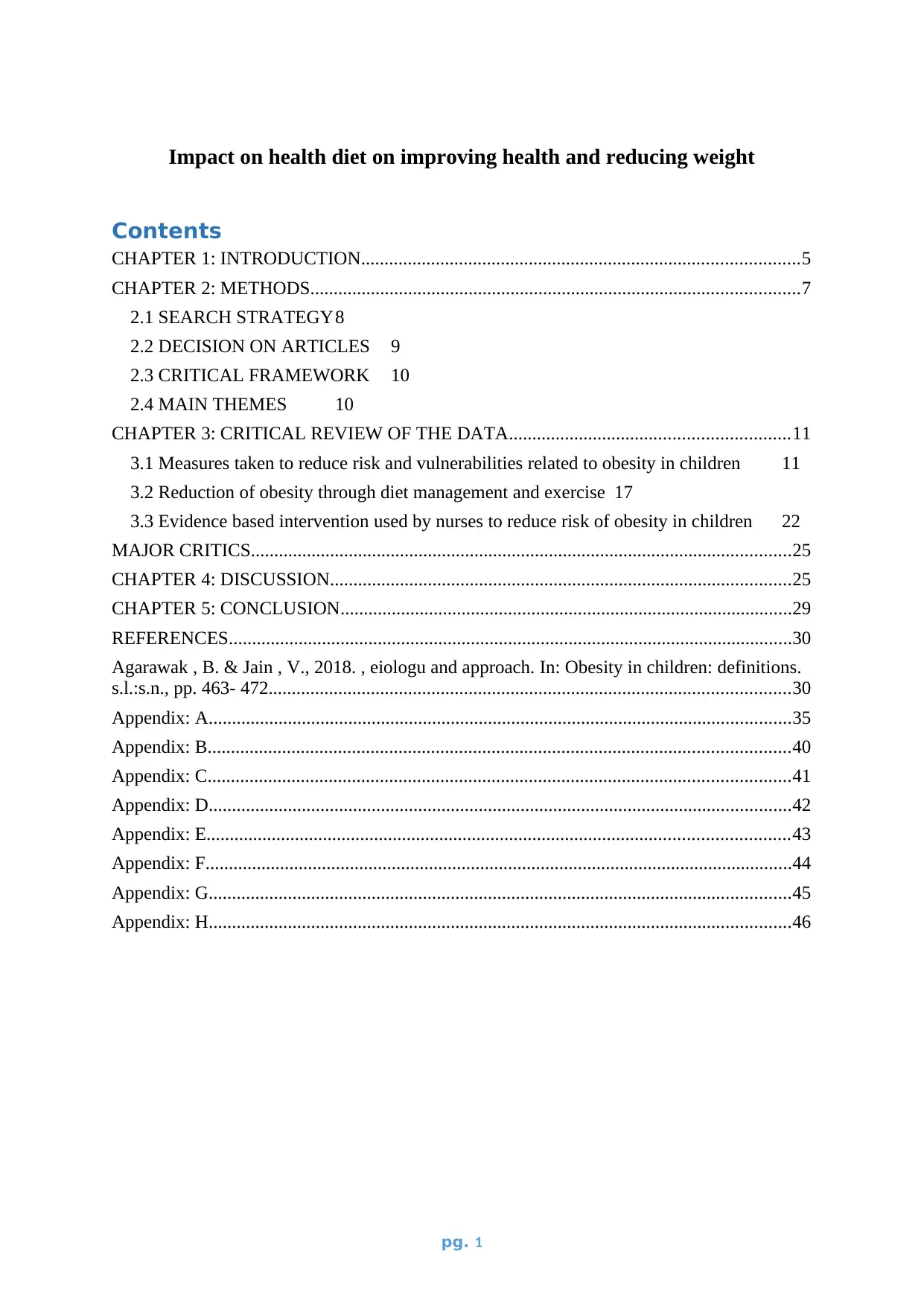
Impact on health diet on improving health and reducing weight
Contents
CHAPTER 1: INTRODUCTION..............................................................................................5
CHAPTER 2: METHODS.........................................................................................................7
2.1 SEARCH STRATEGY8
2.2 DECISION ON ARTICLES 9
2.3 CRITICAL FRAMEWORK 10
2.4 MAIN THEMES 10
CHAPTER 3: CRITICAL REVIEW OF THE DATA............................................................11
3.1 Measures taken to reduce risk and vulnerabilities related to obesity in children 11
3.2 Reduction of obesity through diet management and exercise 17
3.3 Evidence based intervention used by nurses to reduce risk of obesity in children 22
MAJOR CRITICS....................................................................................................................25
CHAPTER 4: DISCUSSION...................................................................................................25
CHAPTER 5: CONCLUSION.................................................................................................29
REFERENCES.........................................................................................................................30
Agarawak , B. & Jain , V., 2018. , eiologu and approach. In: Obesity in children: definitions.
s.l.:s.n., pp. 463- 472................................................................................................................30
Appendix: A.............................................................................................................................35
Appendix: B.............................................................................................................................40
Appendix: C.............................................................................................................................41
Appendix: D.............................................................................................................................42
Appendix: E.............................................................................................................................43
Appendix: F..............................................................................................................................44
Appendix: G.............................................................................................................................45
Appendix: H.............................................................................................................................46
pg. 1
Contents
CHAPTER 1: INTRODUCTION..............................................................................................5
CHAPTER 2: METHODS.........................................................................................................7
2.1 SEARCH STRATEGY8
2.2 DECISION ON ARTICLES 9
2.3 CRITICAL FRAMEWORK 10
2.4 MAIN THEMES 10
CHAPTER 3: CRITICAL REVIEW OF THE DATA............................................................11
3.1 Measures taken to reduce risk and vulnerabilities related to obesity in children 11
3.2 Reduction of obesity through diet management and exercise 17
3.3 Evidence based intervention used by nurses to reduce risk of obesity in children 22
MAJOR CRITICS....................................................................................................................25
CHAPTER 4: DISCUSSION...................................................................................................25
CHAPTER 5: CONCLUSION.................................................................................................29
REFERENCES.........................................................................................................................30
Agarawak , B. & Jain , V., 2018. , eiologu and approach. In: Obesity in children: definitions.
s.l.:s.n., pp. 463- 472................................................................................................................30
Appendix: A.............................................................................................................................35
Appendix: B.............................................................................................................................40
Appendix: C.............................................................................................................................41
Appendix: D.............................................................................................................................42
Appendix: E.............................................................................................................................43
Appendix: F..............................................................................................................................44
Appendix: G.............................................................................................................................45
Appendix: H.............................................................................................................................46
pg. 1
Paraphrase This Document
Need a fresh take? Get an instant paraphrase of this document with our AI Paraphraser
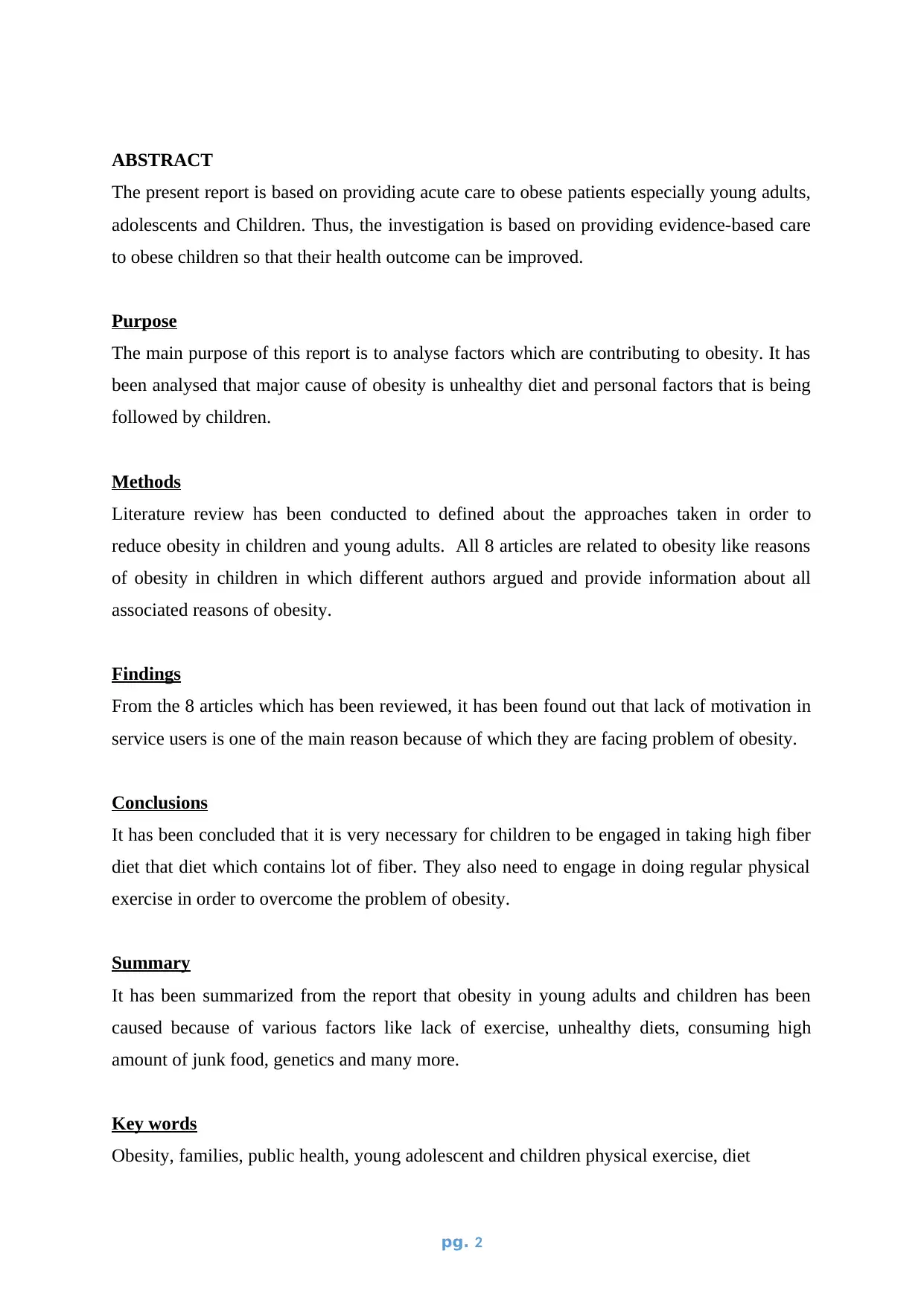
ABSTRACT
The present report is based on providing acute care to obese patients especially young adults,
adolescents and Children. Thus, the investigation is based on providing evidence-based care
to obese children so that their health outcome can be improved.
Purpose
The main purpose of this report is to analyse factors which are contributing to obesity. It has
been analysed that major cause of obesity is unhealthy diet and personal factors that is being
followed by children.
Methods
Literature review has been conducted to defined about the approaches taken in order to
reduce obesity in children and young adults. All 8 articles are related to obesity like reasons
of obesity in children in which different authors argued and provide information about all
associated reasons of obesity.
Findings
From the 8 articles which has been reviewed, it has been found out that lack of motivation in
service users is one of the main reason because of which they are facing problem of obesity.
Conclusions
It has been concluded that it is very necessary for children to be engaged in taking high fiber
diet that diet which contains lot of fiber. They also need to engage in doing regular physical
exercise in order to overcome the problem of obesity.
Summary
It has been summarized from the report that obesity in young adults and children has been
caused because of various factors like lack of exercise, unhealthy diets, consuming high
amount of junk food, genetics and many more.
Key words
Obesity, families, public health, young adolescent and children physical exercise, diet
pg. 2
The present report is based on providing acute care to obese patients especially young adults,
adolescents and Children. Thus, the investigation is based on providing evidence-based care
to obese children so that their health outcome can be improved.
Purpose
The main purpose of this report is to analyse factors which are contributing to obesity. It has
been analysed that major cause of obesity is unhealthy diet and personal factors that is being
followed by children.
Methods
Literature review has been conducted to defined about the approaches taken in order to
reduce obesity in children and young adults. All 8 articles are related to obesity like reasons
of obesity in children in which different authors argued and provide information about all
associated reasons of obesity.
Findings
From the 8 articles which has been reviewed, it has been found out that lack of motivation in
service users is one of the main reason because of which they are facing problem of obesity.
Conclusions
It has been concluded that it is very necessary for children to be engaged in taking high fiber
diet that diet which contains lot of fiber. They also need to engage in doing regular physical
exercise in order to overcome the problem of obesity.
Summary
It has been summarized from the report that obesity in young adults and children has been
caused because of various factors like lack of exercise, unhealthy diets, consuming high
amount of junk food, genetics and many more.
Key words
Obesity, families, public health, young adolescent and children physical exercise, diet
pg. 2
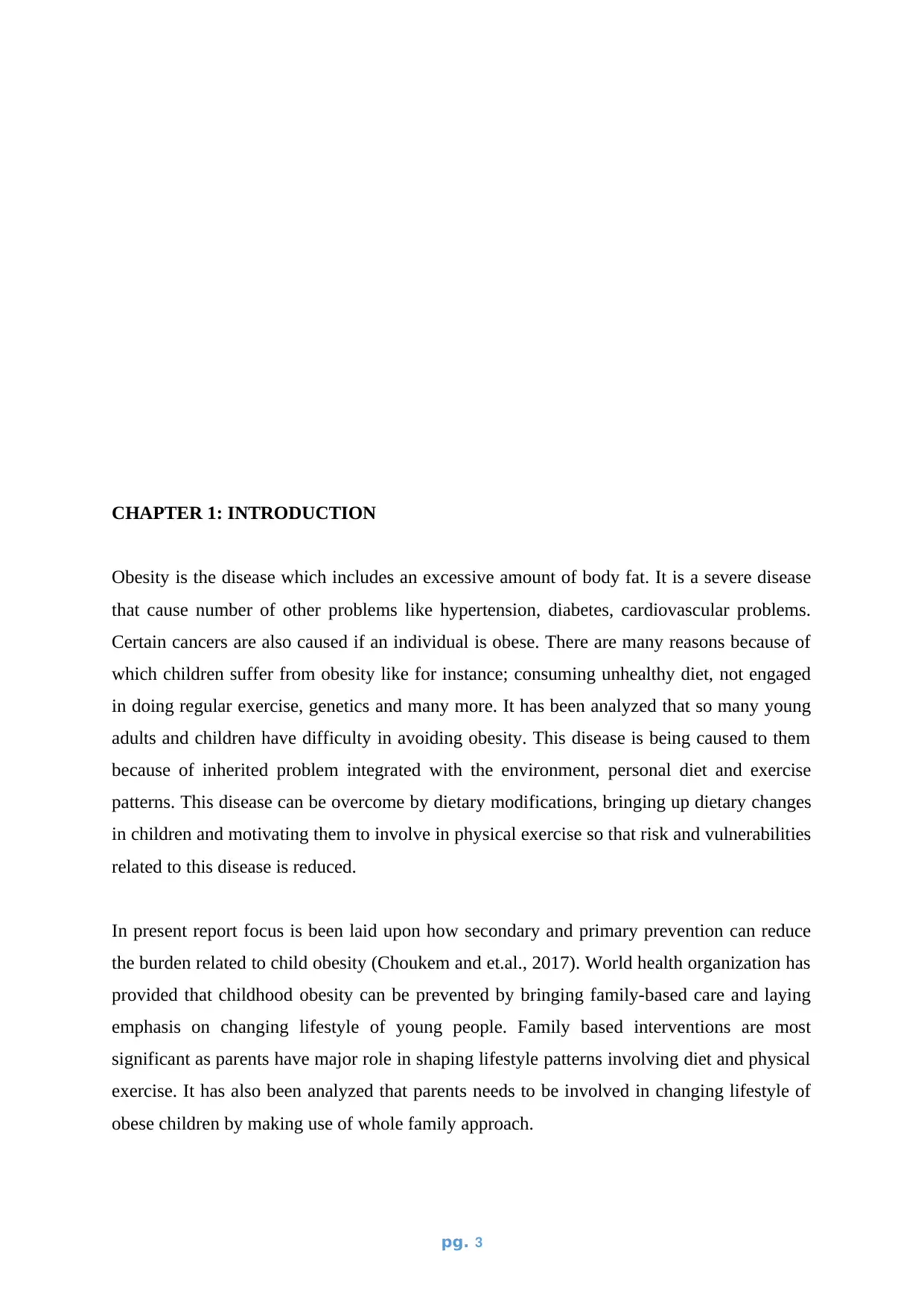
CHAPTER 1: INTRODUCTION
Obesity is the disease which includes an excessive amount of body fat. It is a severe disease
that cause number of other problems like hypertension, diabetes, cardiovascular problems.
Certain cancers are also caused if an individual is obese. There are many reasons because of
which children suffer from obesity like for instance; consuming unhealthy diet, not engaged
in doing regular exercise, genetics and many more. It has been analyzed that so many young
adults and children have difficulty in avoiding obesity. This disease is being caused to them
because of inherited problem integrated with the environment, personal diet and exercise
patterns. This disease can be overcome by dietary modifications, bringing up dietary changes
in children and motivating them to involve in physical exercise so that risk and vulnerabilities
related to this disease is reduced.
In present report focus is been laid upon how secondary and primary prevention can reduce
the burden related to child obesity (Choukem and et.al., 2017). World health organization has
provided that childhood obesity can be prevented by bringing family-based care and laying
emphasis on changing lifestyle of young people. Family based interventions are most
significant as parents have major role in shaping lifestyle patterns involving diet and physical
exercise. It has also been analyzed that parents needs to be involved in changing lifestyle of
obese children by making use of whole family approach.
pg. 3
Obesity is the disease which includes an excessive amount of body fat. It is a severe disease
that cause number of other problems like hypertension, diabetes, cardiovascular problems.
Certain cancers are also caused if an individual is obese. There are many reasons because of
which children suffer from obesity like for instance; consuming unhealthy diet, not engaged
in doing regular exercise, genetics and many more. It has been analyzed that so many young
adults and children have difficulty in avoiding obesity. This disease is being caused to them
because of inherited problem integrated with the environment, personal diet and exercise
patterns. This disease can be overcome by dietary modifications, bringing up dietary changes
in children and motivating them to involve in physical exercise so that risk and vulnerabilities
related to this disease is reduced.
In present report focus is been laid upon how secondary and primary prevention can reduce
the burden related to child obesity (Choukem and et.al., 2017). World health organization has
provided that childhood obesity can be prevented by bringing family-based care and laying
emphasis on changing lifestyle of young people. Family based interventions are most
significant as parents have major role in shaping lifestyle patterns involving diet and physical
exercise. It has also been analyzed that parents needs to be involved in changing lifestyle of
obese children by making use of whole family approach.
pg. 3
⊘ This is a preview!⊘
Do you want full access?
Subscribe today to unlock all pages.

Trusted by 1+ million students worldwide
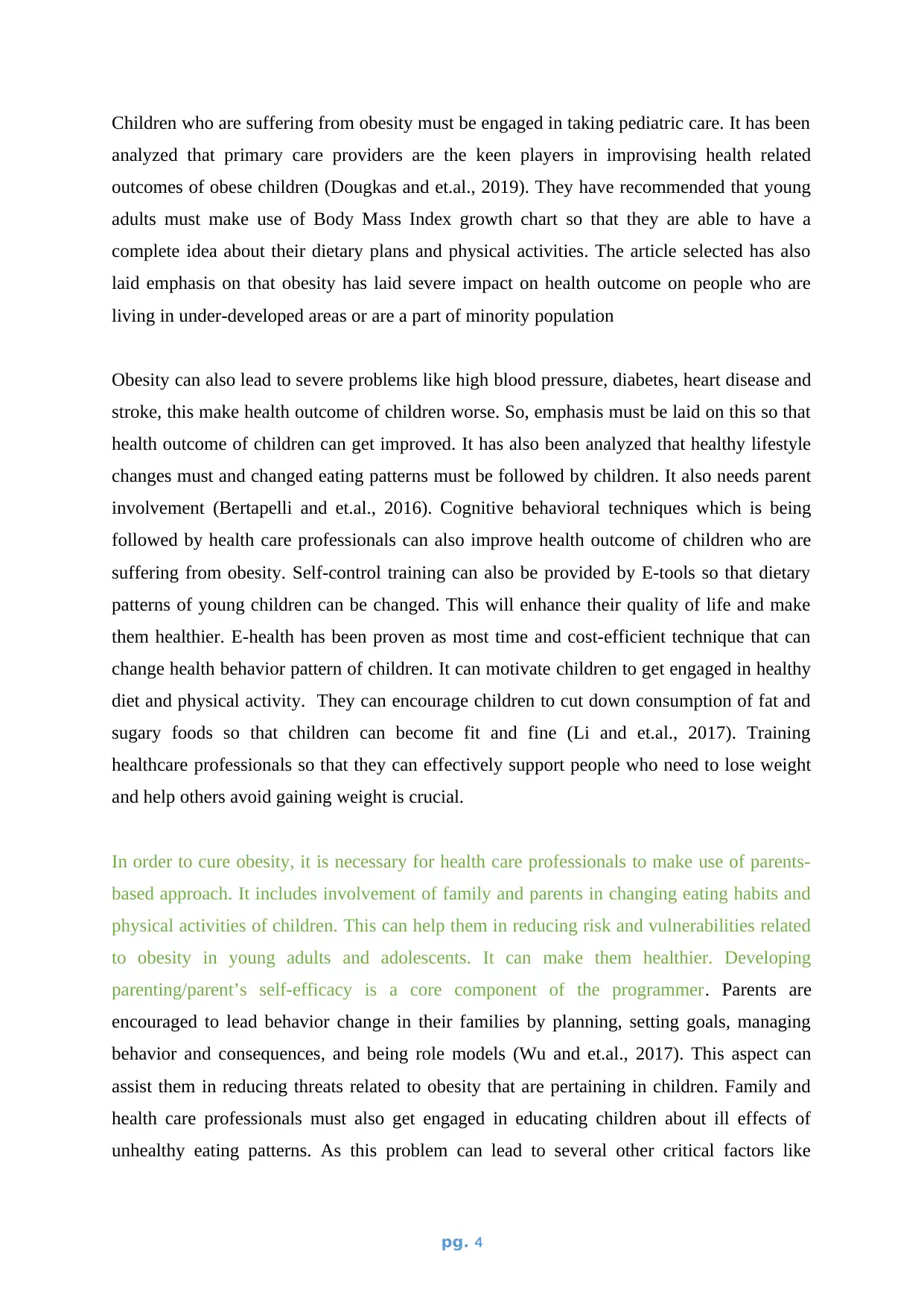
Children who are suffering from obesity must be engaged in taking pediatric care. It has been
analyzed that primary care providers are the keen players in improvising health related
outcomes of obese children (Dougkas and et.al., 2019). They have recommended that young
adults must make use of Body Mass Index growth chart so that they are able to have a
complete idea about their dietary plans and physical activities. The article selected has also
laid emphasis on that obesity has laid severe impact on health outcome on people who are
living in under-developed areas or are a part of minority population
Obesity can also lead to severe problems like high blood pressure, diabetes, heart disease and
stroke, this make health outcome of children worse. So, emphasis must be laid on this so that
health outcome of children can get improved. It has also been analyzed that healthy lifestyle
changes must and changed eating patterns must be followed by children. It also needs parent
involvement (Bertapelli and et.al., 2016). Cognitive behavioral techniques which is being
followed by health care professionals can also improve health outcome of children who are
suffering from obesity. Self-control training can also be provided by E-tools so that dietary
patterns of young children can be changed. This will enhance their quality of life and make
them healthier. E-health has been proven as most time and cost-efficient technique that can
change health behavior pattern of children. It can motivate children to get engaged in healthy
diet and physical activity. They can encourage children to cut down consumption of fat and
sugary foods so that children can become fit and fine (Li and et.al., 2017). Training
healthcare professionals so that they can effectively support people who need to lose weight
and help others avoid gaining weight is crucial.
In order to cure obesity, it is necessary for health care professionals to make use of parents-
based approach. It includes involvement of family and parents in changing eating habits and
physical activities of children. This can help them in reducing risk and vulnerabilities related
to obesity in young adults and adolescents. It can make them healthier. Developing
parenting/parent’s self-efficacy is a core component of the programmer. Parents are
encouraged to lead behavior change in their families by planning, setting goals, managing
behavior and consequences, and being role models (Wu and et.al., 2017). This aspect can
assist them in reducing threats related to obesity that are pertaining in children. Family and
health care professionals must also get engaged in educating children about ill effects of
unhealthy eating patterns. As this problem can lead to several other critical factors like
pg. 4
analyzed that primary care providers are the keen players in improvising health related
outcomes of obese children (Dougkas and et.al., 2019). They have recommended that young
adults must make use of Body Mass Index growth chart so that they are able to have a
complete idea about their dietary plans and physical activities. The article selected has also
laid emphasis on that obesity has laid severe impact on health outcome on people who are
living in under-developed areas or are a part of minority population
Obesity can also lead to severe problems like high blood pressure, diabetes, heart disease and
stroke, this make health outcome of children worse. So, emphasis must be laid on this so that
health outcome of children can get improved. It has also been analyzed that healthy lifestyle
changes must and changed eating patterns must be followed by children. It also needs parent
involvement (Bertapelli and et.al., 2016). Cognitive behavioral techniques which is being
followed by health care professionals can also improve health outcome of children who are
suffering from obesity. Self-control training can also be provided by E-tools so that dietary
patterns of young children can be changed. This will enhance their quality of life and make
them healthier. E-health has been proven as most time and cost-efficient technique that can
change health behavior pattern of children. It can motivate children to get engaged in healthy
diet and physical activity. They can encourage children to cut down consumption of fat and
sugary foods so that children can become fit and fine (Li and et.al., 2017). Training
healthcare professionals so that they can effectively support people who need to lose weight
and help others avoid gaining weight is crucial.
In order to cure obesity, it is necessary for health care professionals to make use of parents-
based approach. It includes involvement of family and parents in changing eating habits and
physical activities of children. This can help them in reducing risk and vulnerabilities related
to obesity in young adults and adolescents. It can make them healthier. Developing
parenting/parent’s self-efficacy is a core component of the programmer. Parents are
encouraged to lead behavior change in their families by planning, setting goals, managing
behavior and consequences, and being role models (Wu and et.al., 2017). This aspect can
assist them in reducing threats related to obesity that are pertaining in children. Family and
health care professionals must also get engaged in educating children about ill effects of
unhealthy eating patterns. As this problem can lead to several other critical factors like
pg. 4
Paraphrase This Document
Need a fresh take? Get an instant paraphrase of this document with our AI Paraphraser
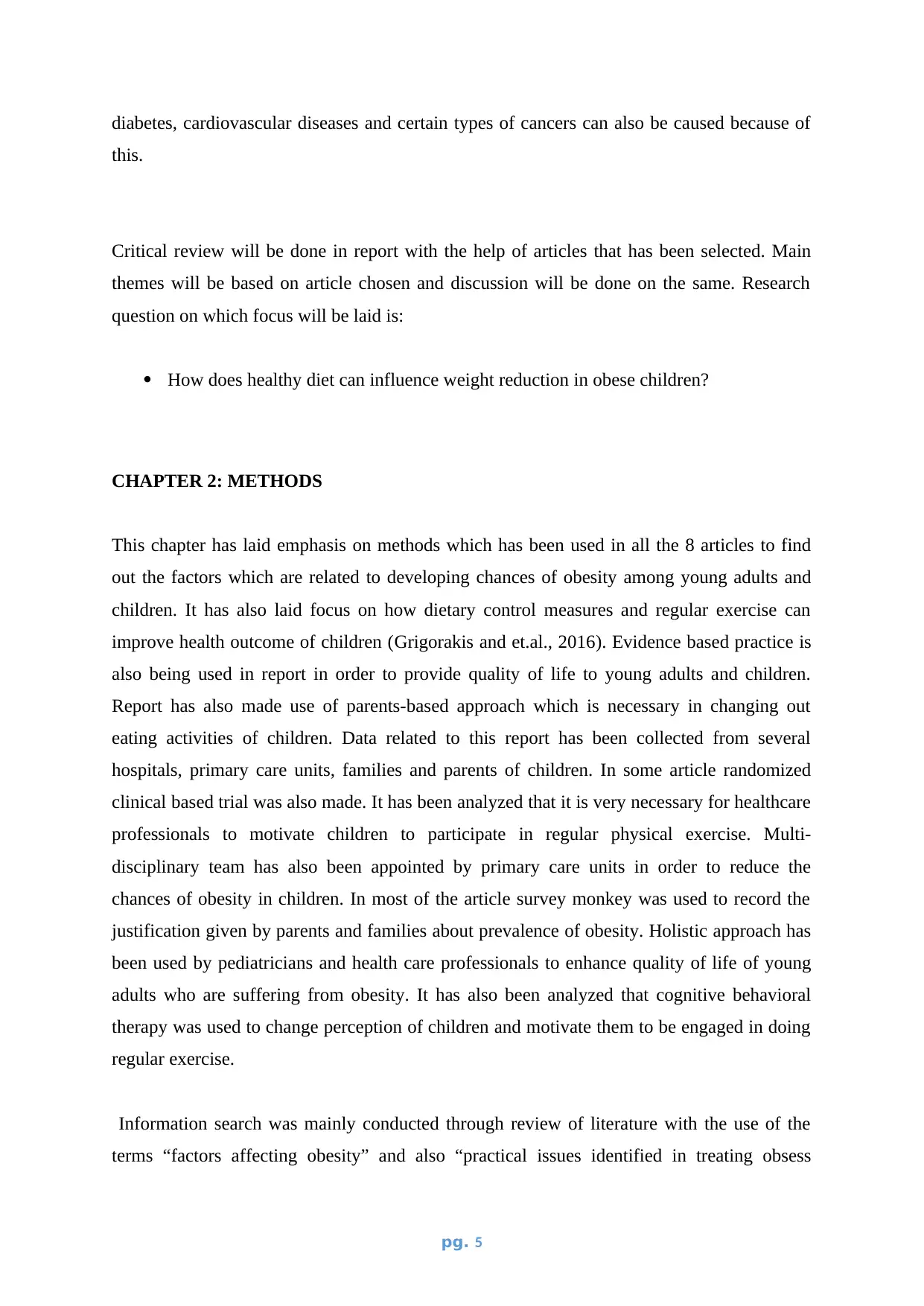
diabetes, cardiovascular diseases and certain types of cancers can also be caused because of
this.
Critical review will be done in report with the help of articles that has been selected. Main
themes will be based on article chosen and discussion will be done on the same. Research
question on which focus will be laid is:
How does healthy diet can influence weight reduction in obese children?
CHAPTER 2: METHODS
This chapter has laid emphasis on methods which has been used in all the 8 articles to find
out the factors which are related to developing chances of obesity among young adults and
children. It has also laid focus on how dietary control measures and regular exercise can
improve health outcome of children (Grigorakis and et.al., 2016). Evidence based practice is
also being used in report in order to provide quality of life to young adults and children.
Report has also made use of parents-based approach which is necessary in changing out
eating activities of children. Data related to this report has been collected from several
hospitals, primary care units, families and parents of children. In some article randomized
clinical based trial was also made. It has been analyzed that it is very necessary for healthcare
professionals to motivate children to participate in regular physical exercise. Multi-
disciplinary team has also been appointed by primary care units in order to reduce the
chances of obesity in children. In most of the article survey monkey was used to record the
justification given by parents and families about prevalence of obesity. Holistic approach has
been used by pediatricians and health care professionals to enhance quality of life of young
adults who are suffering from obesity. It has also been analyzed that cognitive behavioral
therapy was used to change perception of children and motivate them to be engaged in doing
regular exercise.
Information search was mainly conducted through review of literature with the use of the
terms “factors affecting obesity” and also “practical issues identified in treating obsess
pg. 5
this.
Critical review will be done in report with the help of articles that has been selected. Main
themes will be based on article chosen and discussion will be done on the same. Research
question on which focus will be laid is:
How does healthy diet can influence weight reduction in obese children?
CHAPTER 2: METHODS
This chapter has laid emphasis on methods which has been used in all the 8 articles to find
out the factors which are related to developing chances of obesity among young adults and
children. It has also laid focus on how dietary control measures and regular exercise can
improve health outcome of children (Grigorakis and et.al., 2016). Evidence based practice is
also being used in report in order to provide quality of life to young adults and children.
Report has also made use of parents-based approach which is necessary in changing out
eating activities of children. Data related to this report has been collected from several
hospitals, primary care units, families and parents of children. In some article randomized
clinical based trial was also made. It has been analyzed that it is very necessary for healthcare
professionals to motivate children to participate in regular physical exercise. Multi-
disciplinary team has also been appointed by primary care units in order to reduce the
chances of obesity in children. In most of the article survey monkey was used to record the
justification given by parents and families about prevalence of obesity. Holistic approach has
been used by pediatricians and health care professionals to enhance quality of life of young
adults who are suffering from obesity. It has also been analyzed that cognitive behavioral
therapy was used to change perception of children and motivate them to be engaged in doing
regular exercise.
Information search was mainly conducted through review of literature with the use of the
terms “factors affecting obesity” and also “practical issues identified in treating obsess
pg. 5
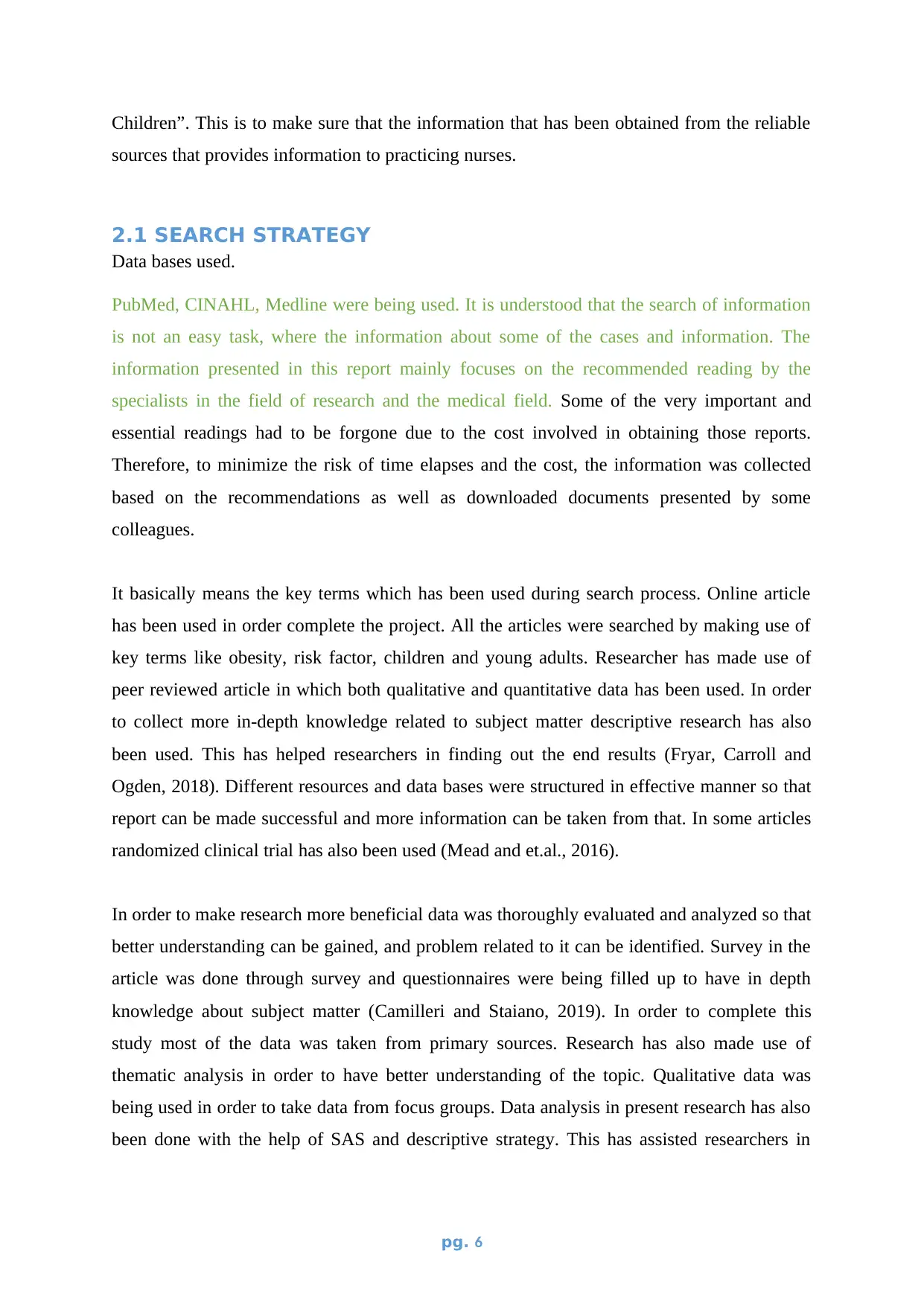
Children”. This is to make sure that the information that has been obtained from the reliable
sources that provides information to practicing nurses.
2.1 SEARCH STRATEGY
Data bases used.
PubMed, CINAHL, Medline were being used. It is understood that the search of information
is not an easy task, where the information about some of the cases and information. The
information presented in this report mainly focuses on the recommended reading by the
specialists in the field of research and the medical field. Some of the very important and
essential readings had to be forgone due to the cost involved in obtaining those reports.
Therefore, to minimize the risk of time elapses and the cost, the information was collected
based on the recommendations as well as downloaded documents presented by some
colleagues.
It basically means the key terms which has been used during search process. Online article
has been used in order complete the project. All the articles were searched by making use of
key terms like obesity, risk factor, children and young adults. Researcher has made use of
peer reviewed article in which both qualitative and quantitative data has been used. In order
to collect more in-depth knowledge related to subject matter descriptive research has also
been used. This has helped researchers in finding out the end results (Fryar, Carroll and
Ogden, 2018). Different resources and data bases were structured in effective manner so that
report can be made successful and more information can be taken from that. In some articles
randomized clinical trial has also been used (Mead and et.al., 2016).
In order to make research more beneficial data was thoroughly evaluated and analyzed so that
better understanding can be gained, and problem related to it can be identified. Survey in the
article was done through survey and questionnaires were being filled up to have in depth
knowledge about subject matter (Camilleri and Staiano, 2019). In order to complete this
study most of the data was taken from primary sources. Research has also made use of
thematic analysis in order to have better understanding of the topic. Qualitative data was
being used in order to take data from focus groups. Data analysis in present research has also
been done with the help of SAS and descriptive strategy. This has assisted researchers in
pg. 6
sources that provides information to practicing nurses.
2.1 SEARCH STRATEGY
Data bases used.
PubMed, CINAHL, Medline were being used. It is understood that the search of information
is not an easy task, where the information about some of the cases and information. The
information presented in this report mainly focuses on the recommended reading by the
specialists in the field of research and the medical field. Some of the very important and
essential readings had to be forgone due to the cost involved in obtaining those reports.
Therefore, to minimize the risk of time elapses and the cost, the information was collected
based on the recommendations as well as downloaded documents presented by some
colleagues.
It basically means the key terms which has been used during search process. Online article
has been used in order complete the project. All the articles were searched by making use of
key terms like obesity, risk factor, children and young adults. Researcher has made use of
peer reviewed article in which both qualitative and quantitative data has been used. In order
to collect more in-depth knowledge related to subject matter descriptive research has also
been used. This has helped researchers in finding out the end results (Fryar, Carroll and
Ogden, 2018). Different resources and data bases were structured in effective manner so that
report can be made successful and more information can be taken from that. In some articles
randomized clinical trial has also been used (Mead and et.al., 2016).
In order to make research more beneficial data was thoroughly evaluated and analyzed so that
better understanding can be gained, and problem related to it can be identified. Survey in the
article was done through survey and questionnaires were being filled up to have in depth
knowledge about subject matter (Camilleri and Staiano, 2019). In order to complete this
study most of the data was taken from primary sources. Research has also made use of
thematic analysis in order to have better understanding of the topic. Qualitative data was
being used in order to take data from focus groups. Data analysis in present research has also
been done with the help of SAS and descriptive strategy. This has assisted researchers in
pg. 6
⊘ This is a preview!⊘
Do you want full access?
Subscribe today to unlock all pages.

Trusted by 1+ million students worldwide
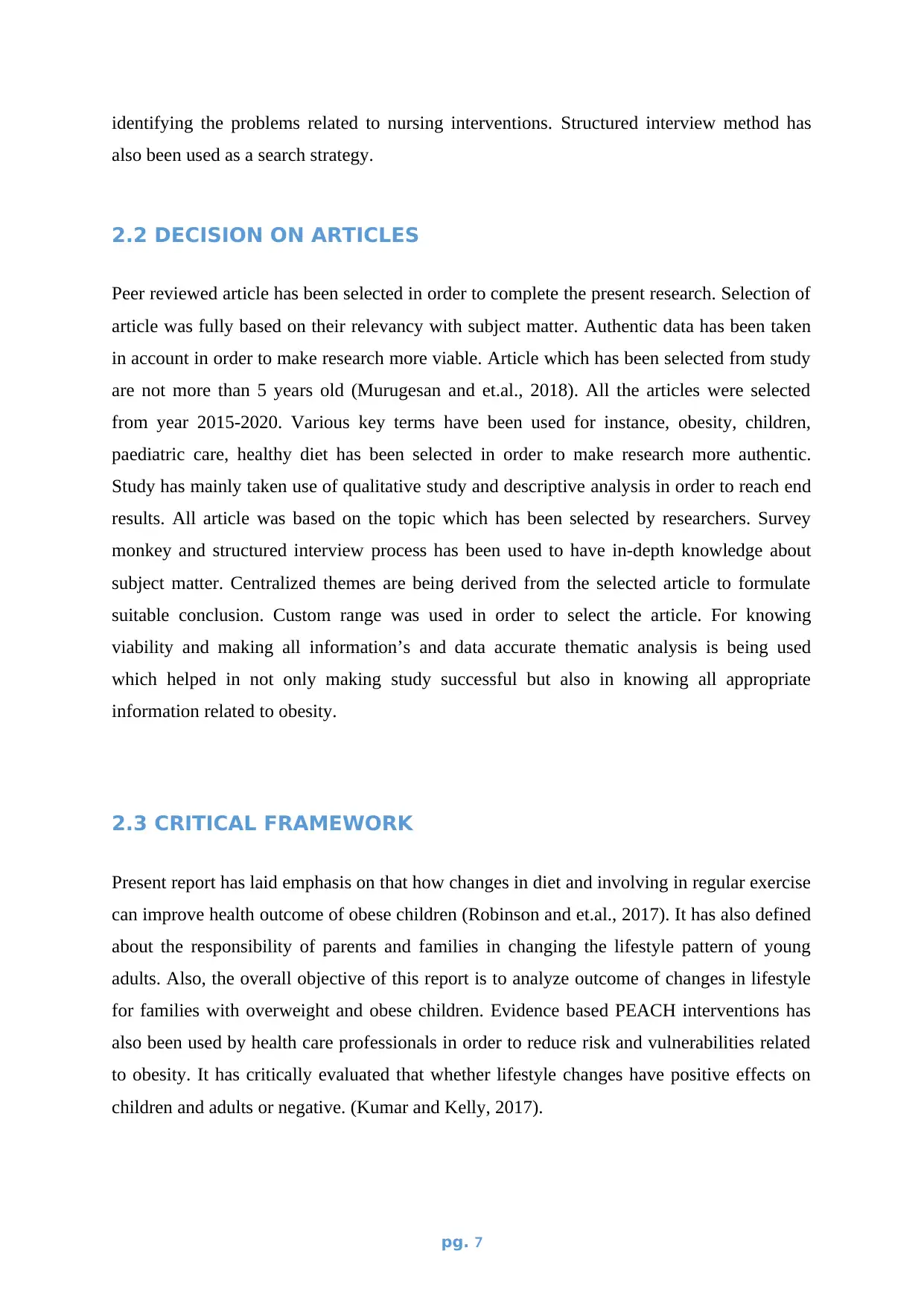
identifying the problems related to nursing interventions. Structured interview method has
also been used as a search strategy.
2.2 DECISION ON ARTICLES
Peer reviewed article has been selected in order to complete the present research. Selection of
article was fully based on their relevancy with subject matter. Authentic data has been taken
in account in order to make research more viable. Article which has been selected from study
are not more than 5 years old (Murugesan and et.al., 2018). All the articles were selected
from year 2015-2020. Various key terms have been used for instance, obesity, children,
paediatric care, healthy diet has been selected in order to make research more authentic.
Study has mainly taken use of qualitative study and descriptive analysis in order to reach end
results. All article was based on the topic which has been selected by researchers. Survey
monkey and structured interview process has been used to have in-depth knowledge about
subject matter. Centralized themes are being derived from the selected article to formulate
suitable conclusion. Custom range was used in order to select the article. For knowing
viability and making all information’s and data accurate thematic analysis is being used
which helped in not only making study successful but also in knowing all appropriate
information related to obesity.
2.3 CRITICAL FRAMEWORK
Present report has laid emphasis on that how changes in diet and involving in regular exercise
can improve health outcome of obese children (Robinson and et.al., 2017). It has also defined
about the responsibility of parents and families in changing the lifestyle pattern of young
adults. Also, the overall objective of this report is to analyze outcome of changes in lifestyle
for families with overweight and obese children. Evidence based PEACH interventions has
also been used by health care professionals in order to reduce risk and vulnerabilities related
to obesity. It has critically evaluated that whether lifestyle changes have positive effects on
children and adults or negative. (Kumar and Kelly, 2017).
pg. 7
also been used as a search strategy.
2.2 DECISION ON ARTICLES
Peer reviewed article has been selected in order to complete the present research. Selection of
article was fully based on their relevancy with subject matter. Authentic data has been taken
in account in order to make research more viable. Article which has been selected from study
are not more than 5 years old (Murugesan and et.al., 2018). All the articles were selected
from year 2015-2020. Various key terms have been used for instance, obesity, children,
paediatric care, healthy diet has been selected in order to make research more authentic.
Study has mainly taken use of qualitative study and descriptive analysis in order to reach end
results. All article was based on the topic which has been selected by researchers. Survey
monkey and structured interview process has been used to have in-depth knowledge about
subject matter. Centralized themes are being derived from the selected article to formulate
suitable conclusion. Custom range was used in order to select the article. For knowing
viability and making all information’s and data accurate thematic analysis is being used
which helped in not only making study successful but also in knowing all appropriate
information related to obesity.
2.3 CRITICAL FRAMEWORK
Present report has laid emphasis on that how changes in diet and involving in regular exercise
can improve health outcome of obese children (Robinson and et.al., 2017). It has also defined
about the responsibility of parents and families in changing the lifestyle pattern of young
adults. Also, the overall objective of this report is to analyze outcome of changes in lifestyle
for families with overweight and obese children. Evidence based PEACH interventions has
also been used by health care professionals in order to reduce risk and vulnerabilities related
to obesity. It has critically evaluated that whether lifestyle changes have positive effects on
children and adults or negative. (Kumar and Kelly, 2017).
pg. 7
Paraphrase This Document
Need a fresh take? Get an instant paraphrase of this document with our AI Paraphraser
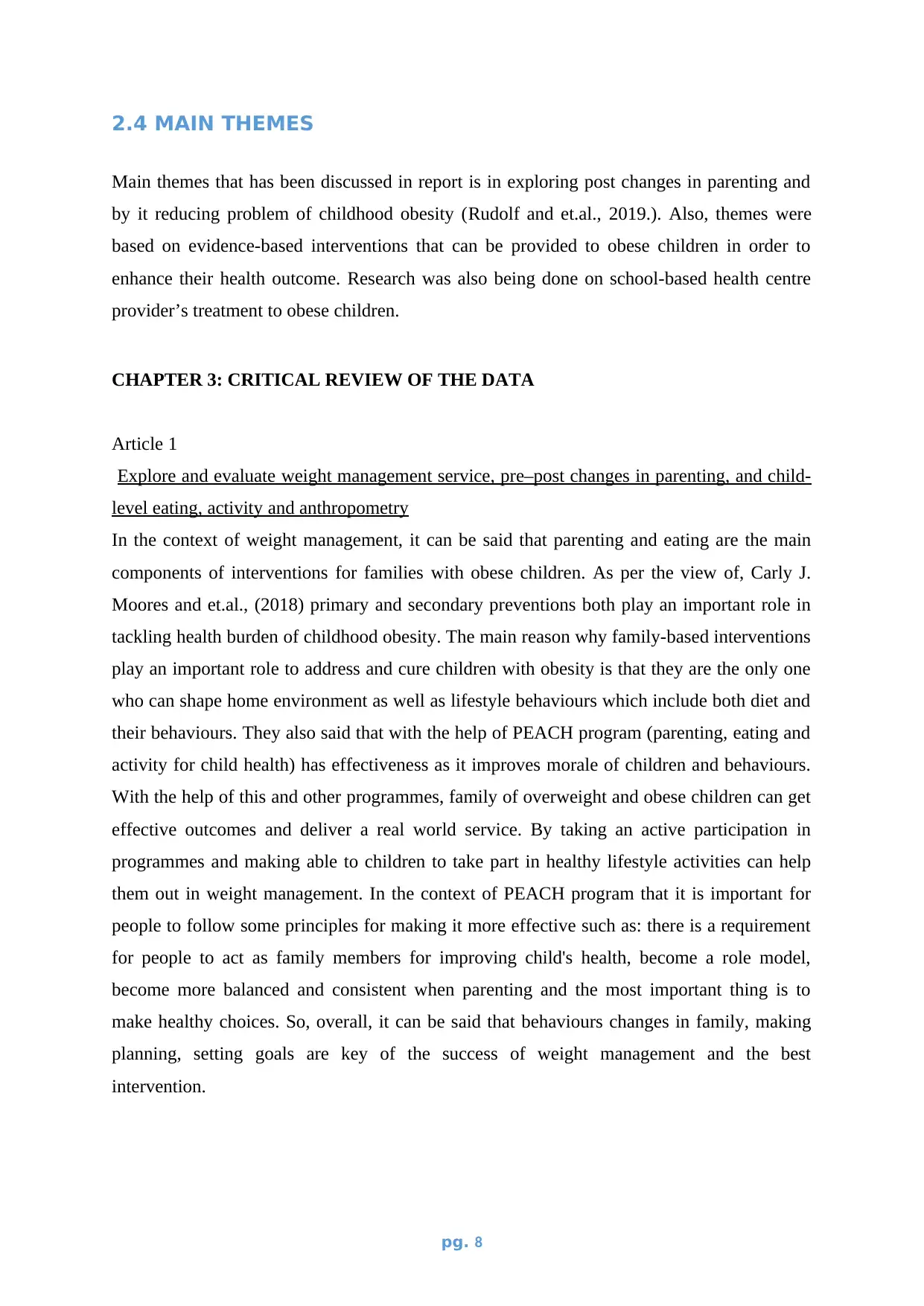
2.4 MAIN THEMES
Main themes that has been discussed in report is in exploring post changes in parenting and
by it reducing problem of childhood obesity (Rudolf and et.al., 2019.). Also, themes were
based on evidence-based interventions that can be provided to obese children in order to
enhance their health outcome. Research was also being done on school-based health centre
provider’s treatment to obese children.
CHAPTER 3: CRITICAL REVIEW OF THE DATA
Article 1
Explore and evaluate weight management service, pre–post changes in parenting, and child-
level eating, activity and anthropometry
In the context of weight management, it can be said that parenting and eating are the main
components of interventions for families with obese children. As per the view of, Carly J.
Moores and et.al., (2018) primary and secondary preventions both play an important role in
tackling health burden of childhood obesity. The main reason why family-based interventions
play an important role to address and cure children with obesity is that they are the only one
who can shape home environment as well as lifestyle behaviours which include both diet and
their behaviours. They also said that with the help of PEACH program (parenting, eating and
activity for child health) has effectiveness as it improves morale of children and behaviours.
With the help of this and other programmes, family of overweight and obese children can get
effective outcomes and deliver a real world service. By taking an active participation in
programmes and making able to children to take part in healthy lifestyle activities can help
them out in weight management. In the context of PEACH program that it is important for
people to follow some principles for making it more effective such as: there is a requirement
for people to act as family members for improving child's health, become a role model,
become more balanced and consistent when parenting and the most important thing is to
make healthy choices. So, overall, it can be said that behaviours changes in family, making
planning, setting goals are key of the success of weight management and the best
intervention.
pg. 8
Main themes that has been discussed in report is in exploring post changes in parenting and
by it reducing problem of childhood obesity (Rudolf and et.al., 2019.). Also, themes were
based on evidence-based interventions that can be provided to obese children in order to
enhance their health outcome. Research was also being done on school-based health centre
provider’s treatment to obese children.
CHAPTER 3: CRITICAL REVIEW OF THE DATA
Article 1
Explore and evaluate weight management service, pre–post changes in parenting, and child-
level eating, activity and anthropometry
In the context of weight management, it can be said that parenting and eating are the main
components of interventions for families with obese children. As per the view of, Carly J.
Moores and et.al., (2018) primary and secondary preventions both play an important role in
tackling health burden of childhood obesity. The main reason why family-based interventions
play an important role to address and cure children with obesity is that they are the only one
who can shape home environment as well as lifestyle behaviours which include both diet and
their behaviours. They also said that with the help of PEACH program (parenting, eating and
activity for child health) has effectiveness as it improves morale of children and behaviours.
With the help of this and other programmes, family of overweight and obese children can get
effective outcomes and deliver a real world service. By taking an active participation in
programmes and making able to children to take part in healthy lifestyle activities can help
them out in weight management. In the context of PEACH program that it is important for
people to follow some principles for making it more effective such as: there is a requirement
for people to act as family members for improving child's health, become a role model,
become more balanced and consistent when parenting and the most important thing is to
make healthy choices. So, overall, it can be said that behaviours changes in family, making
planning, setting goals are key of the success of weight management and the best
intervention.
pg. 8
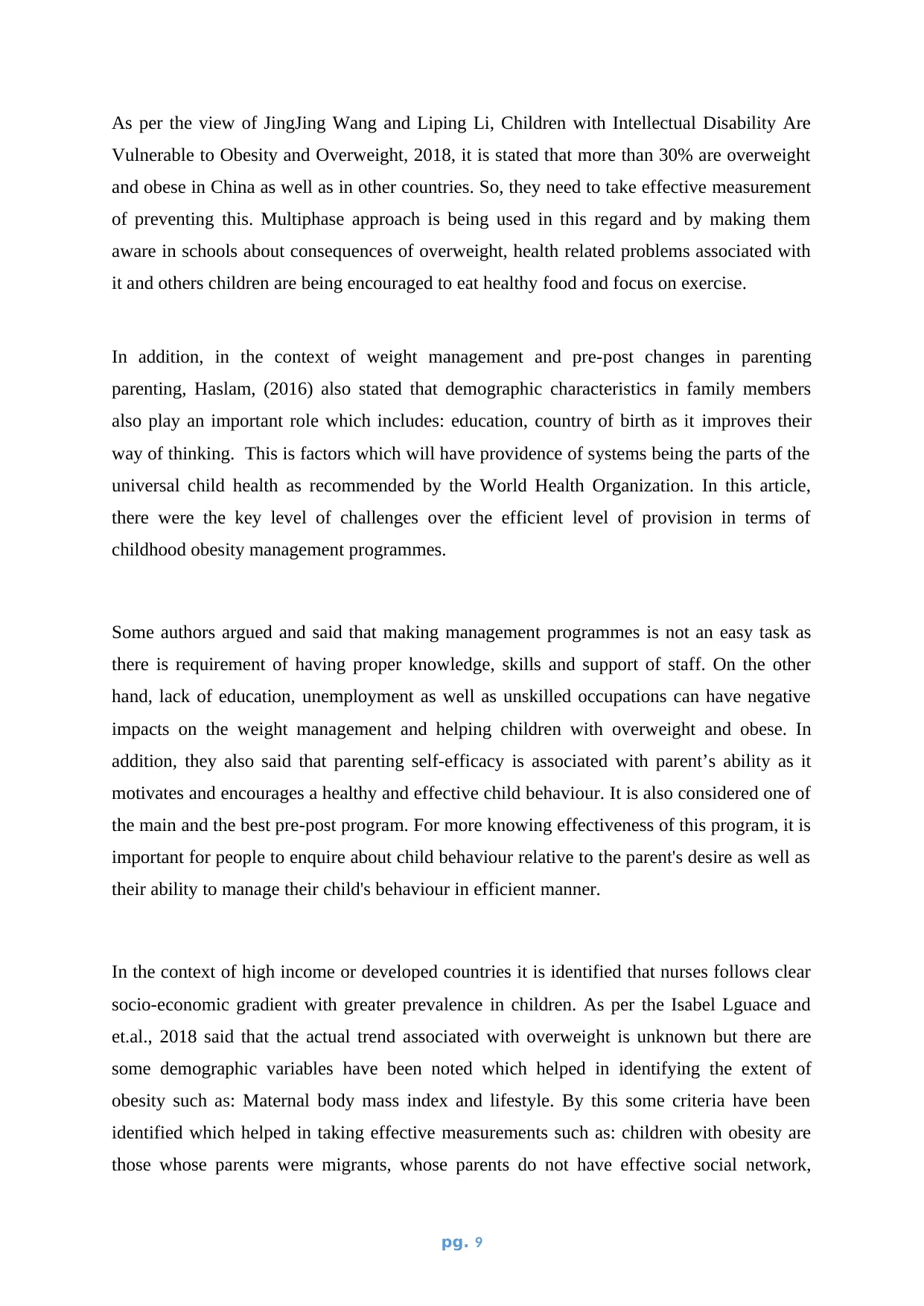
As per the view of JingJing Wang and Liping Li, Children with Intellectual Disability Are
Vulnerable to Obesity and Overweight, 2018, it is stated that more than 30% are overweight
and obese in China as well as in other countries. So, they need to take effective measurement
of preventing this. Multiphase approach is being used in this regard and by making them
aware in schools about consequences of overweight, health related problems associated with
it and others children are being encouraged to eat healthy food and focus on exercise.
In addition, in the context of weight management and pre-post changes in parenting
parenting, Haslam, (2016) also stated that demographic characteristics in family members
also play an important role which includes: education, country of birth as it improves their
way of thinking. This is factors which will have providence of systems being the parts of the
universal child health as recommended by the World Health Organization. In this article,
there were the key level of challenges over the efficient level of provision in terms of
childhood obesity management programmes.
Some authors argued and said that making management programmes is not an easy task as
there is requirement of having proper knowledge, skills and support of staff. On the other
hand, lack of education, unemployment as well as unskilled occupations can have negative
impacts on the weight management and helping children with overweight and obese. In
addition, they also said that parenting self-efficacy is associated with parent’s ability as it
motivates and encourages a healthy and effective child behaviour. It is also considered one of
the main and the best pre-post program. For more knowing effectiveness of this program, it is
important for people to enquire about child behaviour relative to the parent's desire as well as
their ability to manage their child's behaviour in efficient manner.
In the context of high income or developed countries it is identified that nurses follows clear
socio-economic gradient with greater prevalence in children. As per the Isabel Lguace and
et.al., 2018 said that the actual trend associated with overweight is unknown but there are
some demographic variables have been noted which helped in identifying the extent of
obesity such as: Maternal body mass index and lifestyle. By this some criteria have been
identified which helped in taking effective measurements such as: children with obesity are
those whose parents were migrants, whose parents do not have effective social network,
pg. 9
Vulnerable to Obesity and Overweight, 2018, it is stated that more than 30% are overweight
and obese in China as well as in other countries. So, they need to take effective measurement
of preventing this. Multiphase approach is being used in this regard and by making them
aware in schools about consequences of overweight, health related problems associated with
it and others children are being encouraged to eat healthy food and focus on exercise.
In addition, in the context of weight management and pre-post changes in parenting
parenting, Haslam, (2016) also stated that demographic characteristics in family members
also play an important role which includes: education, country of birth as it improves their
way of thinking. This is factors which will have providence of systems being the parts of the
universal child health as recommended by the World Health Organization. In this article,
there were the key level of challenges over the efficient level of provision in terms of
childhood obesity management programmes.
Some authors argued and said that making management programmes is not an easy task as
there is requirement of having proper knowledge, skills and support of staff. On the other
hand, lack of education, unemployment as well as unskilled occupations can have negative
impacts on the weight management and helping children with overweight and obese. In
addition, they also said that parenting self-efficacy is associated with parent’s ability as it
motivates and encourages a healthy and effective child behaviour. It is also considered one of
the main and the best pre-post program. For more knowing effectiveness of this program, it is
important for people to enquire about child behaviour relative to the parent's desire as well as
their ability to manage their child's behaviour in efficient manner.
In the context of high income or developed countries it is identified that nurses follows clear
socio-economic gradient with greater prevalence in children. As per the Isabel Lguace and
et.al., 2018 said that the actual trend associated with overweight is unknown but there are
some demographic variables have been noted which helped in identifying the extent of
obesity such as: Maternal body mass index and lifestyle. By this some criteria have been
identified which helped in taking effective measurements such as: children with obesity are
those whose parents were migrants, whose parents do not have effective social network,
pg. 9
⊘ This is a preview!⊘
Do you want full access?
Subscribe today to unlock all pages.

Trusted by 1+ million students worldwide
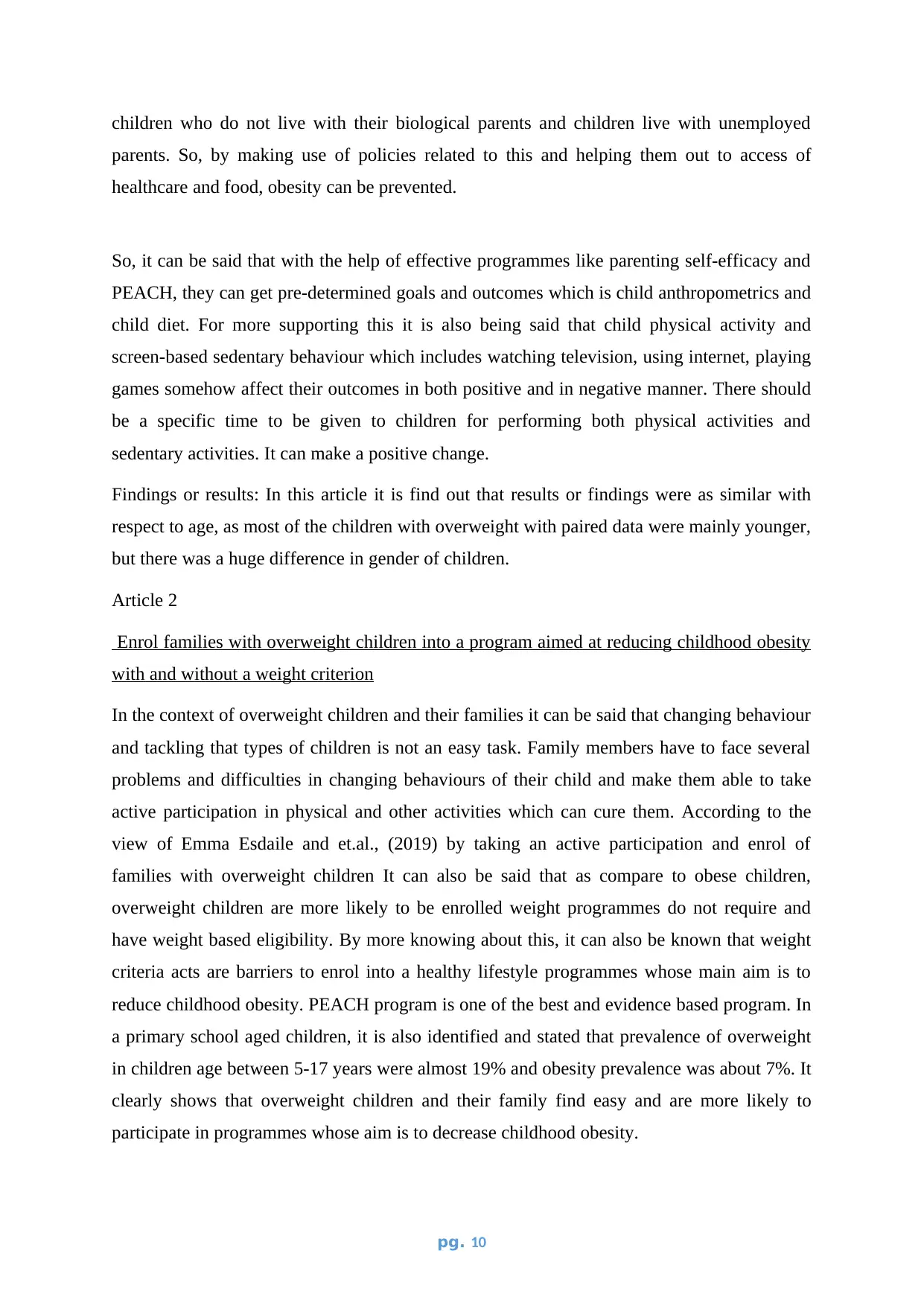
children who do not live with their biological parents and children live with unemployed
parents. So, by making use of policies related to this and helping them out to access of
healthcare and food, obesity can be prevented.
So, it can be said that with the help of effective programmes like parenting self-efficacy and
PEACH, they can get pre-determined goals and outcomes which is child anthropometrics and
child diet. For more supporting this it is also being said that child physical activity and
screen-based sedentary behaviour which includes watching television, using internet, playing
games somehow affect their outcomes in both positive and in negative manner. There should
be a specific time to be given to children for performing both physical activities and
sedentary activities. It can make a positive change.
Findings or results: In this article it is find out that results or findings were as similar with
respect to age, as most of the children with overweight with paired data were mainly younger,
but there was a huge difference in gender of children.
Article 2
Enrol families with overweight children into a program aimed at reducing childhood obesity
with and without a weight criterion
In the context of overweight children and their families it can be said that changing behaviour
and tackling that types of children is not an easy task. Family members have to face several
problems and difficulties in changing behaviours of their child and make them able to take
active participation in physical and other activities which can cure them. According to the
view of Emma Esdaile and et.al., (2019) by taking an active participation and enrol of
families with overweight children It can also be said that as compare to obese children,
overweight children are more likely to be enrolled weight programmes do not require and
have weight based eligibility. By more knowing about this, it can also be known that weight
criteria acts are barriers to enrol into a healthy lifestyle programmes whose main aim is to
reduce childhood obesity. PEACH program is one of the best and evidence based program. In
a primary school aged children, it is also identified and stated that prevalence of overweight
in children age between 5-17 years were almost 19% and obesity prevalence was about 7%. It
clearly shows that overweight children and their family find easy and are more likely to
participate in programmes whose aim is to decrease childhood obesity.
pg. 10
parents. So, by making use of policies related to this and helping them out to access of
healthcare and food, obesity can be prevented.
So, it can be said that with the help of effective programmes like parenting self-efficacy and
PEACH, they can get pre-determined goals and outcomes which is child anthropometrics and
child diet. For more supporting this it is also being said that child physical activity and
screen-based sedentary behaviour which includes watching television, using internet, playing
games somehow affect their outcomes in both positive and in negative manner. There should
be a specific time to be given to children for performing both physical activities and
sedentary activities. It can make a positive change.
Findings or results: In this article it is find out that results or findings were as similar with
respect to age, as most of the children with overweight with paired data were mainly younger,
but there was a huge difference in gender of children.
Article 2
Enrol families with overweight children into a program aimed at reducing childhood obesity
with and without a weight criterion
In the context of overweight children and their families it can be said that changing behaviour
and tackling that types of children is not an easy task. Family members have to face several
problems and difficulties in changing behaviours of their child and make them able to take
active participation in physical and other activities which can cure them. According to the
view of Emma Esdaile and et.al., (2019) by taking an active participation and enrol of
families with overweight children It can also be said that as compare to obese children,
overweight children are more likely to be enrolled weight programmes do not require and
have weight based eligibility. By more knowing about this, it can also be known that weight
criteria acts are barriers to enrol into a healthy lifestyle programmes whose main aim is to
reduce childhood obesity. PEACH program is one of the best and evidence based program. In
a primary school aged children, it is also identified and stated that prevalence of overweight
in children age between 5-17 years were almost 19% and obesity prevalence was about 7%. It
clearly shows that overweight children and their family find easy and are more likely to
participate in programmes whose aim is to decrease childhood obesity.
pg. 10
Paraphrase This Document
Need a fresh take? Get an instant paraphrase of this document with our AI Paraphraser
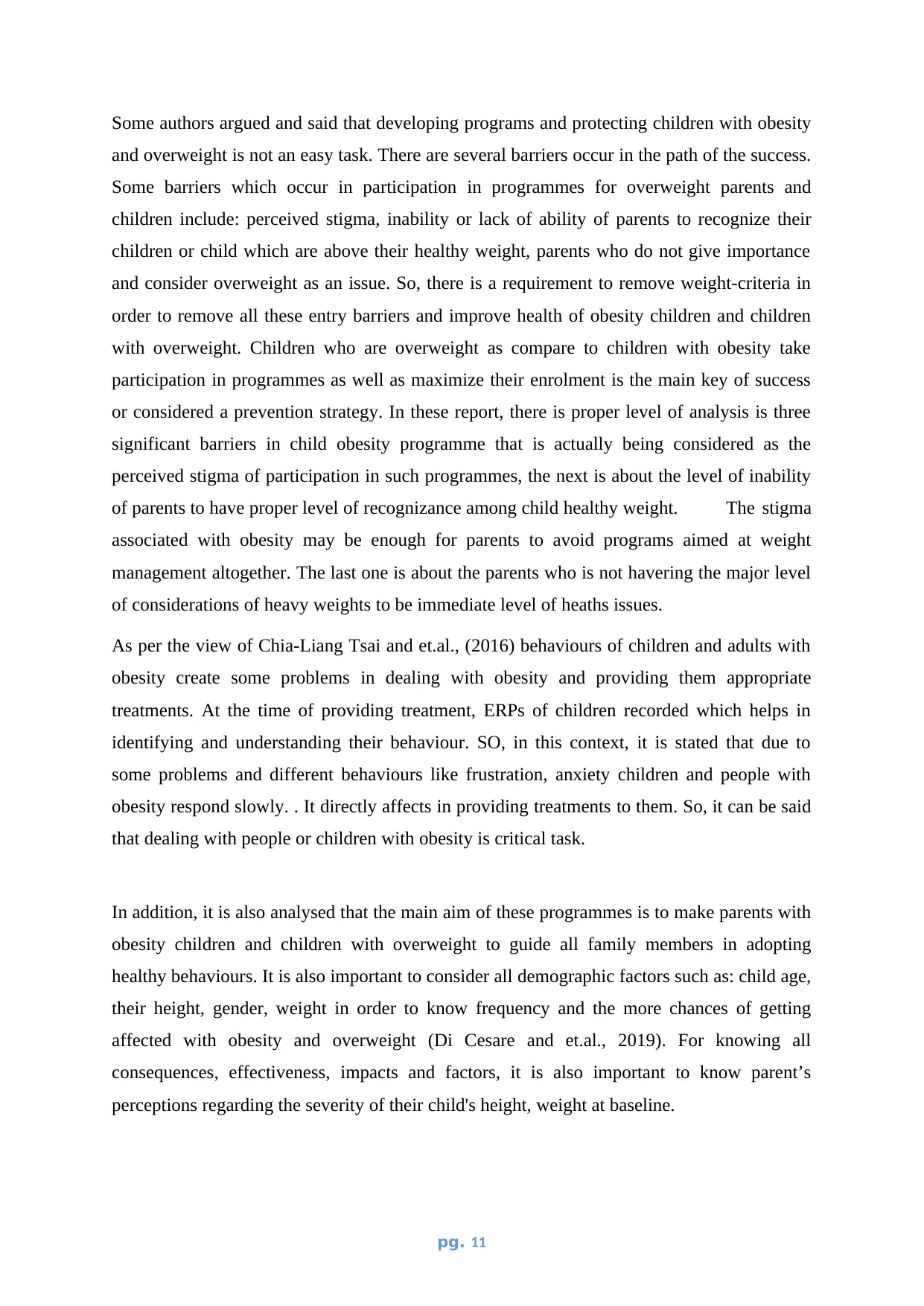
Some authors argued and said that developing programs and protecting children with obesity
and overweight is not an easy task. There are several barriers occur in the path of the success.
Some barriers which occur in participation in programmes for overweight parents and
children include: perceived stigma, inability or lack of ability of parents to recognize their
children or child which are above their healthy weight, parents who do not give importance
and consider overweight as an issue. So, there is a requirement to remove weight-criteria in
order to remove all these entry barriers and improve health of obesity children and children
with overweight. Children who are overweight as compare to children with obesity take
participation in programmes as well as maximize their enrolment is the main key of success
or considered a prevention strategy. In these report, there is proper level of analysis is three
significant barriers in child obesity programme that is actually being considered as the
perceived stigma of participation in such programmes, the next is about the level of inability
of parents to have proper level of recognizance among child healthy weight. The stigma
associated with obesity may be enough for parents to avoid programs aimed at weight
management altogether. The last one is about the parents who is not havering the major level
of considerations of heavy weights to be immediate level of heaths issues.
As per the view of Chia-Liang Tsai and et.al., (2016) behaviours of children and adults with
obesity create some problems in dealing with obesity and providing them appropriate
treatments. At the time of providing treatment, ERPs of children recorded which helps in
identifying and understanding their behaviour. SO, in this context, it is stated that due to
some problems and different behaviours like frustration, anxiety children and people with
obesity respond slowly. . It directly affects in providing treatments to them. So, it can be said
that dealing with people or children with obesity is critical task.
In addition, it is also analysed that the main aim of these programmes is to make parents with
obesity children and children with overweight to guide all family members in adopting
healthy behaviours. It is also important to consider all demographic factors such as: child age,
their height, gender, weight in order to know frequency and the more chances of getting
affected with obesity and overweight (Di Cesare and et.al., 2019). For knowing all
consequences, effectiveness, impacts and factors, it is also important to know parent’s
perceptions regarding the severity of their child's height, weight at baseline.
pg. 11
and overweight is not an easy task. There are several barriers occur in the path of the success.
Some barriers which occur in participation in programmes for overweight parents and
children include: perceived stigma, inability or lack of ability of parents to recognize their
children or child which are above their healthy weight, parents who do not give importance
and consider overweight as an issue. So, there is a requirement to remove weight-criteria in
order to remove all these entry barriers and improve health of obesity children and children
with overweight. Children who are overweight as compare to children with obesity take
participation in programmes as well as maximize their enrolment is the main key of success
or considered a prevention strategy. In these report, there is proper level of analysis is three
significant barriers in child obesity programme that is actually being considered as the
perceived stigma of participation in such programmes, the next is about the level of inability
of parents to have proper level of recognizance among child healthy weight. The stigma
associated with obesity may be enough for parents to avoid programs aimed at weight
management altogether. The last one is about the parents who is not havering the major level
of considerations of heavy weights to be immediate level of heaths issues.
As per the view of Chia-Liang Tsai and et.al., (2016) behaviours of children and adults with
obesity create some problems in dealing with obesity and providing them appropriate
treatments. At the time of providing treatment, ERPs of children recorded which helps in
identifying and understanding their behaviour. SO, in this context, it is stated that due to
some problems and different behaviours like frustration, anxiety children and people with
obesity respond slowly. . It directly affects in providing treatments to them. So, it can be said
that dealing with people or children with obesity is critical task.
In addition, it is also analysed that the main aim of these programmes is to make parents with
obesity children and children with overweight to guide all family members in adopting
healthy behaviours. It is also important to consider all demographic factors such as: child age,
their height, gender, weight in order to know frequency and the more chances of getting
affected with obesity and overweight (Di Cesare and et.al., 2019). For knowing all
consequences, effectiveness, impacts and factors, it is also important to know parent’s
perceptions regarding the severity of their child's height, weight at baseline.
pg. 11
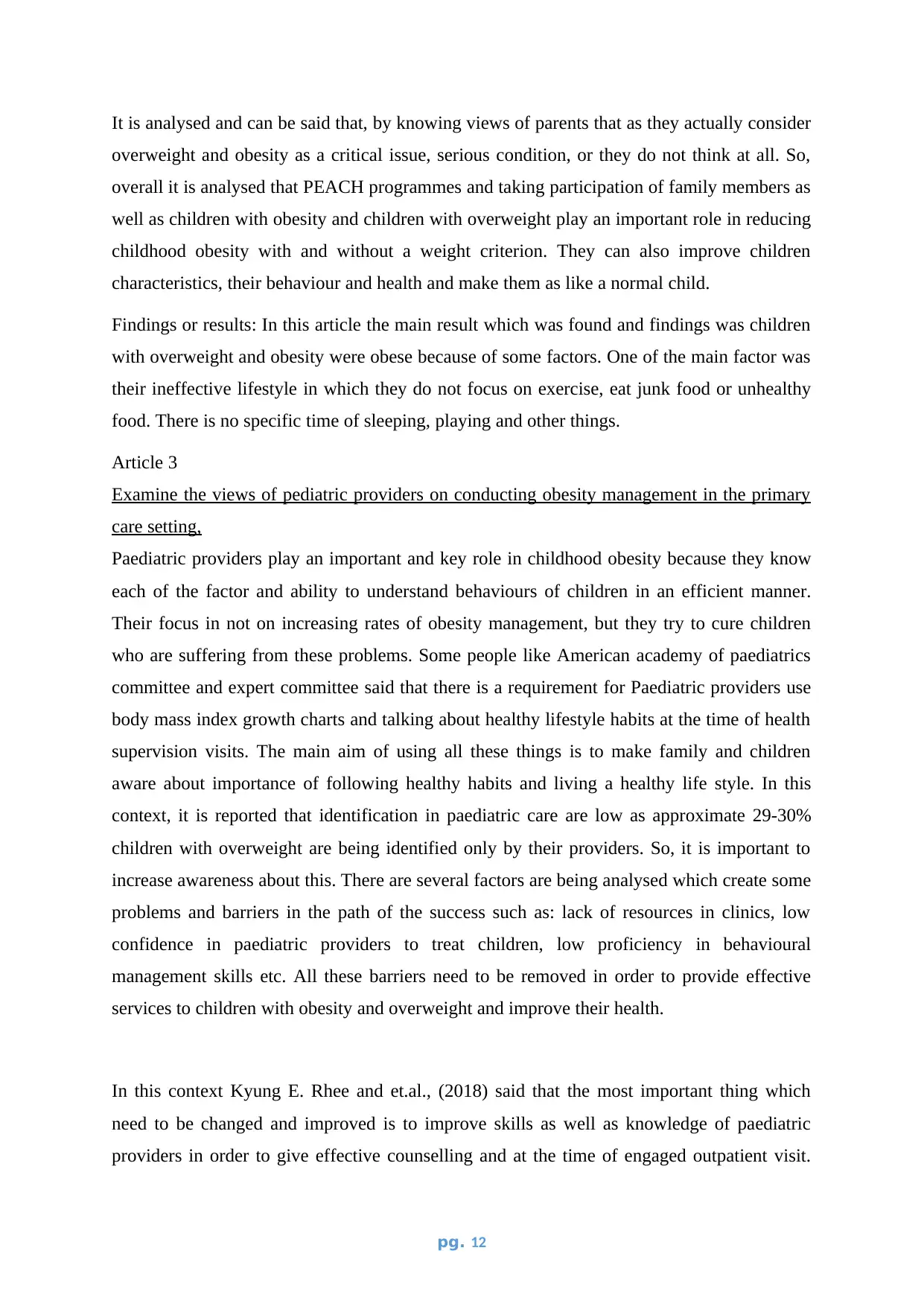
It is analysed and can be said that, by knowing views of parents that as they actually consider
overweight and obesity as a critical issue, serious condition, or they do not think at all. So,
overall it is analysed that PEACH programmes and taking participation of family members as
well as children with obesity and children with overweight play an important role in reducing
childhood obesity with and without a weight criterion. They can also improve children
characteristics, their behaviour and health and make them as like a normal child.
Findings or results: In this article the main result which was found and findings was children
with overweight and obesity were obese because of some factors. One of the main factor was
their ineffective lifestyle in which they do not focus on exercise, eat junk food or unhealthy
food. There is no specific time of sleeping, playing and other things.
Article 3
Examine the views of pediatric providers on conducting obesity management in the primary
care setting,
Paediatric providers play an important and key role in childhood obesity because they know
each of the factor and ability to understand behaviours of children in an efficient manner.
Their focus in not on increasing rates of obesity management, but they try to cure children
who are suffering from these problems. Some people like American academy of paediatrics
committee and expert committee said that there is a requirement for Paediatric providers use
body mass index growth charts and talking about healthy lifestyle habits at the time of health
supervision visits. The main aim of using all these things is to make family and children
aware about importance of following healthy habits and living a healthy life style. In this
context, it is reported that identification in paediatric care are low as approximate 29-30%
children with overweight are being identified only by their providers. So, it is important to
increase awareness about this. There are several factors are being analysed which create some
problems and barriers in the path of the success such as: lack of resources in clinics, low
confidence in paediatric providers to treat children, low proficiency in behavioural
management skills etc. All these barriers need to be removed in order to provide effective
services to children with obesity and overweight and improve their health.
In this context Kyung E. Rhee and et.al., (2018) said that the most important thing which
need to be changed and improved is to improve skills as well as knowledge of paediatric
providers in order to give effective counselling and at the time of engaged outpatient visit.
pg. 12
overweight and obesity as a critical issue, serious condition, or they do not think at all. So,
overall it is analysed that PEACH programmes and taking participation of family members as
well as children with obesity and children with overweight play an important role in reducing
childhood obesity with and without a weight criterion. They can also improve children
characteristics, their behaviour and health and make them as like a normal child.
Findings or results: In this article the main result which was found and findings was children
with overweight and obesity were obese because of some factors. One of the main factor was
their ineffective lifestyle in which they do not focus on exercise, eat junk food or unhealthy
food. There is no specific time of sleeping, playing and other things.
Article 3
Examine the views of pediatric providers on conducting obesity management in the primary
care setting,
Paediatric providers play an important and key role in childhood obesity because they know
each of the factor and ability to understand behaviours of children in an efficient manner.
Their focus in not on increasing rates of obesity management, but they try to cure children
who are suffering from these problems. Some people like American academy of paediatrics
committee and expert committee said that there is a requirement for Paediatric providers use
body mass index growth charts and talking about healthy lifestyle habits at the time of health
supervision visits. The main aim of using all these things is to make family and children
aware about importance of following healthy habits and living a healthy life style. In this
context, it is reported that identification in paediatric care are low as approximate 29-30%
children with overweight are being identified only by their providers. So, it is important to
increase awareness about this. There are several factors are being analysed which create some
problems and barriers in the path of the success such as: lack of resources in clinics, low
confidence in paediatric providers to treat children, low proficiency in behavioural
management skills etc. All these barriers need to be removed in order to provide effective
services to children with obesity and overweight and improve their health.
In this context Kyung E. Rhee and et.al., (2018) said that the most important thing which
need to be changed and improved is to improve skills as well as knowledge of paediatric
providers in order to give effective counselling and at the time of engaged outpatient visit.
pg. 12
⊘ This is a preview!⊘
Do you want full access?
Subscribe today to unlock all pages.

Trusted by 1+ million students worldwide
1 out of 49
Related Documents
Your All-in-One AI-Powered Toolkit for Academic Success.
+13062052269
info@desklib.com
Available 24*7 on WhatsApp / Email
![[object Object]](/_next/static/media/star-bottom.7253800d.svg)
Unlock your academic potential
Copyright © 2020–2025 A2Z Services. All Rights Reserved. Developed and managed by ZUCOL.





